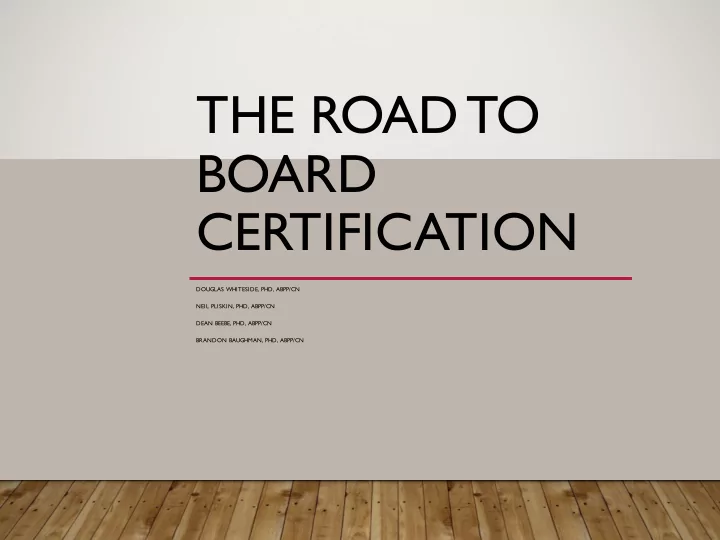

THE ROAD TO BOARD CERTIFICATION DOUGLAS WHITESIDE, PHD, ABPP/CN NEIL PLISKIN, PHD, ABPP/CN DEAN BEEBE, PHD, ABPP/CN BRANDON BAUGHMAN, PHD, ABPP/CN
ADVICE ON NEUROPSYCHOLOGICAL TRAINING • Competition for neuropsychology internships and post-doctoral fellowships is strong • Internship imbalance is well known and well-documented. Last year was better, but little data on long term trends • However, there are even fewer neuropsychology track internships are out there. • The good news is interns may be able to still meet Houston Conference internship criteria • But caveat emptor !
COMPETITIVENESS FOR INTERNSHIP • T op tier candidates have several characteristics in common: 1. At least 2 years of neuropsychology practicum training 2. With multiple ABPP/CN supervisors 3. From an APA accredited program with a Neuropsychology emphasis run by ABPP neuropsychologist 4. Co-authorship on at least 1-2 peer reviewed publications. First authorship is even better 5. Consistent record of conference presentations (at least 1 per year for each year of graduate school)
COMPETITIVENESS FOR INTERNSHIP • 5. Very strong letters of recommendations from at least one ABPP neuropsychologist (>1 is better) • 6. Dissertation complete prior to internship • 7. No academic problems • 8. At least 5 years in graduate school prior to internship • 9. The keys are LOTS of fully integrated assessment batteries and a record of sustained commitment and work to becoming a neuropsychologist • 10. Be prepared to spend extra time in graduate school and do more than peers who are pursuing clinical psychology careers.
COMPETITIVENESS FOR POST -DOC • APA accredited internship! (I cant emphasize this enough). • Seriously, don’t rank non-APA accredited programs • If you don’t match the first year, get more neuropsychology experience, more research, finish your dissertation. • T ry again. • Neuropsychology track on internship is great, but more critical is at least 50% time in NP with ABPP neuropsychologist. • 3 really strong LOR, all written by ABPP (combination of your graduate school, practicum, and internship supervisors). You MUST have your ABPP internship supervisor write you a letter for post-doc.
COMPETITIVENESS FOR POST -DOC • Have dissertation completed no later than the time you start applying for post-docs. • Continue to be involved in research (publications and presentations). • Apply to geographically diverse post-docs (same is very true for internships). • Apply to APPCN post-doc programs.
POST -DOCS • What’s APPCN? Association of Post-doctoral Programs in Clinical Neuropsychology • APA accreditation at post-doc level is not common • So all APPCN member programs complete a self-study • Because of this, graduates from APPCN post-docs are on the fast track to ABPP • Specifically, APPCN alumni circumvent the full credential review that other applicants must complete.
POST -DOCS • Match versus Non-match programs • Some programs do not participate in the match. • Often the trainees must accept or decline an offer from non-match program before even getting a chance to interview with match programs. • Some non-match programs have excellent training, but candidates need to evaluate programs carefully.
APPCN MATCH • In the Midwest, almost all high quality programs are in the match (UIC, Medical College of Milwaukee, University of Iowa, etc) • In the Northeast and West Coast, fewer are in the match. • Match statistics-there’s more applicants than positions • This is driving the intense competition.
APPCN MATCH-RECENT STATISTICS FOR THE POST -DOC MATCH: 2007 2008 2009 2010 2011 2012 2013 2014 2015 Applicant participation Applicants registered in Match 150 159 147 187 175 167 160 184 170 Applicants who withdrew or with no rankings 40 (27%) 47 (30%) 53 (36%) 62 (33%) 48 (27%) 50 (29%) 54 (33%) 64 (35%) 58 (34%) Applicants participating in the match 110 112 94 125 127 117 106 120 112 Applicant match results 61 77 63 84 73 77 73 86 74 (55%) (69%) (67%) (67%) (57%) (66%) (69%) (72%) (66%) Applicants matched 49 35 31 41 40 33 34 38 (45%) (31%) (33%) (33%) 54 (43% (34)% (31%) (28%) (34%) Applicants not matched Program participation Training sites participating in the match 47 55 55 59 58 60 57 64 57 Positions offered in the match 73 82 75 89 79 84 80 94 79 Program match results Positions filled in the match 61 (84%) 77 (94%) 63 (84%) 84 (94%) 73 (92%) 77 (92%) 73 (91%) 86 (91%) 74 (94%) Unfilled positions after match 12 (16%) 5 (6%) 12 (16%) 5 (6%) 6 (8%) 7 (8%) 7 (9%) 9 (9%) 5 (6%) Programs with unfilled positions 9 (16%) 5 (8%) 10 (15%) 5 (7%) 6 (9%) 7 (10%) 7 (11%) 7 (9%) 5 (8%) Avg # of applicants ranked per position Programs filling all positions 6 6.6 7.2 8.1 8.3 8.5 7.1 7.9 7.1 Programs with unfilled positions 1.9 5 3.4 6 1.8 5.7 3.9 3 3.8 All programs 5.3 6.5 6.6 8 7.7 8.3 6.8 7.4 6.8 Avg # of rankings submitted per applicant Matched applicants 4.8 5.5 6.4 6.2 6.5 6.9 6.4 5.7 6 Unmatched applicants 2.3 3.3 2.5 3.8 2.7 2.4 2.1 3.6 3.1 Overall 3.7 4.8 5.1 5.4 4.9 5.3 5.1 5.1 5
Recommend
More recommend